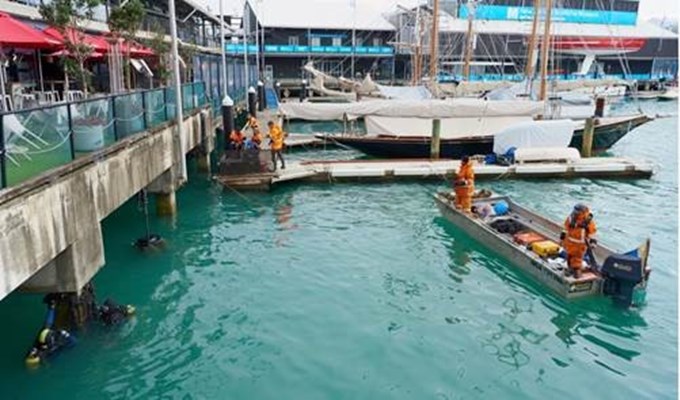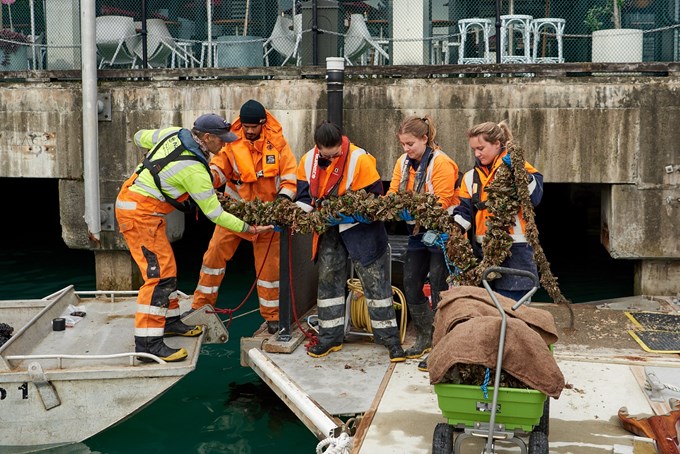The terrestrial transformation of Downtown Auckland is being accompanied by an equally radical shift in how the marine environment in the Ferry Basin can be revitalised.
Te Wānanga, the downtown public space, was conceived and co-designed with mana whenua as a tidal shelf extending into Te Waitematā Harbour, interspersed with ‘tidal pool’ apertures letting light into the depths below.
An environment where coastal and marine habitats could evolve and flourish.
Eric van Essen, Programme Director of the Downtown Programme, says the space is a fusion of culture, environment and ecology.
The textured surfaces of Te Wānanga will encourage the attachment of seaweeds, barnacles and periwinkles; wharf piles will attract roosting seabirds and ropes of green lipped mussels (kūtai) could create an environment where water quality and biodiversity is improved.
Mr van Essen says a trial to explore the ecological effects of ropes of Kūtai is underway in the Ferry Basin and around the Maritime Museum.
Marcus Cameron, a project scientist on the trial and a senior aquatic scientist with Tonkin+Taylor describes the remarkable water filtering capacity of mussels.
“A single mature mussel can filter up to 150 to 200 litres of seawater a day taking in phytoplankton for nourishment as well as removing pollutants. They effectively serve as bio-indicators of aquatic health and may enhance the environment to support and attract other marine species.”
“We will monitor the mussels for effects on biodiversity which we anticipate will support the growth of native species of kūtai, kelp, fish and a number of invertebrates like decorator crabs. There is also an important biosecurity element and we will be monitoring for any unwanted invasive species,” he says.
The trial is a partnership between mana whenua, the New Zealand Maritime Museum and the Downtown Programme and represents an exciting development in the vision of Te Wānanga to restore the mauri of Te Waitematā Harbour.
Around 100m of seeded mussel lines, weighing approximately 600kg were delivered from the Firth of Thames where North Island Mussels Limited have their operation.
They arrived at Kelly Tarlton’s on June 16 for the start of the trial, where they were immersed in fresh water for 90 minutes as a biosecurity measure to kill any hitchhiking Mediterranean fan worm, invasive sea squirt and Asian kelp.
They then went into a tank of saltwater overnight, so they were not stressed when relocated to the harbour. They range in size from 70-110mm and are about 18 months old – an age when mussels are often harvested for eating - but these mussels are not destined for the table!
The following day the seeded ropes were transported to the Maritime Museum where they were blessed by representatives of ngā Mana Whenua o Tāmaki Makaurau.

Mr van Essen says it was quite an operation. Divers attached the kūtai ropes to two waka floats and three pile wraps and assisted in the hanging of the ropes from six pontoons in the Maritime Museum and Ferry Basin. The final batch of kūtai were attached to these structures on 24 June.
The results from the trial will form an important part of the Maritime Museum’s education and engagement programme about the issues we face around water quality, environmental degradation, biosecurity and biodiversity in Auckland’s waterways.
“This outcome beautifully encapsulates Te Wānanga’s potential to encourage deeper understanding and appreciation of the integral relationship between different ecosystems.”
Ultimately, it is hoped, up to 40 kūtai ropes will be attached to the underside of the elevated tidal shelf of Te Wānanga. Information gleaned from the trial will be extremely useful to inform the design and approach for how this will work.
Mr van Essen says once anchored in place, the kūtai ropes will provide a truly living and organic connection between the city and the harbour.
Mai i te moana ki te whenua, mai i te whenua ki te moana - from the sea to land, from the land to the sea (the endless unbroken continuum).
Mr van Essen acknowledges the collaborative partnership between Mana Whenua o Tāmaki Makaurau, Kaitiaki Forum, Richelle Kahui-McConnell (Mealofa Ltd), Dr Jarrod Walker (Tataki Ltd), Auckland Transport, Auckland Council, Isthmus, TSA, Tonkin+Taylor, Downtown JV, Quality Equipment, New Zealand Maritime Museum, Kelly Tarlton’s, North Island Mussels Limited, New Zealand Diving and Salvage Ltd, Total Marine, Ministry for Primary Industries (MPI Biosecurity).


